
고온조건에서 라이시미터를 이용한 천궁의 증산 및 탄소축적량 분석
 ; Kwang Seop Kim2
; Kwang Seop Kim2 ; Dong Chun Kim3
; Dong Chun Kim3 ; Hyo Hoon Nam4
; Hyo Hoon Nam4 ; Jun Hyung Kim5
; Jun Hyung Kim5 ; Bu Yong Lee6
; Bu Yong Lee6
This is an open access article distributed under the terms of the Creative Commons Attribution Non-Commercial License (http://creativecommons.org/licenses/by-nc/3.0/) which permits unrestricted non-commercial use, distribution, and reproduction in any medium, provided the original work is properly cited.
Abstract
Evaluation of transpiration is required for agricultural and environmental management applications, as crop yields and plant growth are primarily water limited. This study aimed to determine the transpiration and carbon accumulation of Cnidium officinale.
The transpiration of C. officinale was evaluated using weighing lysimeter. The relationship between transpiration and factors such as solar radiation, air temperature, and leaf area was assessed. Transpiration increased as the leaf area increased with the growth stage. Furthermore, daily transpiration per unit leaf area was 0.69 ± 0.16 g·㎝−2·day−1 and there were no significant differences in daily transpiration during the cultivation period. The maximum transpiration was 620.6 g m−2·h−1 and diurnal changes in transpiration were highly correlated with solar radiation although the maximum transpiration was observed at the air temperatures of 20℃ - 26℃. The ratio of carbon accumulation to transpiration was 0.12%.
Our results indicated that the transpiration of C. officinale is primarily regulated by solar radiation energy on clear days and that 97% of the water is discharged through transpiration for heat dissipation. Therefore, weighing lysimeters can measure transpiration accurately and may be useful in interpreting plant growth.
Keywords:
Cnidium officinale Makino, Leaf Area, Solar Radiation, Transpiration서 언
천궁 (Cnidium officinale Makino)은 산형과 (Umbelliferae)에 속하는 다년생 식물로 지하부 근경을 건조하여 한약재로 사용하며 국내에서는 식품에 제한적 원료로 사용이 가능하여 중풍, 통증질환, 부인과 질환의 치료에 많이 사용되고 있다 (Baek et al., 2003). 또한 항산화 활성 (Lee et al., 2002), 뇌질환 관련 효능 (Kim et al., 2003) 및 광범위한 항균 활성이 있어 천연 항산화제, 화장품 소재로 활용이 증가하는 추세이다 (Yi, 2004; Oh et al., 2010; Um et al., 2017).
재배적지는 최고온도 30℃ 이하의 서늘하고 햇볕이 너무 강하지 않으며 일교차 큰 곳으로 알려져 있으나 (Kim et al., 2013) 기후변화로 재배면적과 생산량이 감소하여 2018년 기준 전국의 재배면적은 116 ㏊, 총 생산량은 1,014 M/T 정도이고 (MAFRA, 2018), 수입량은 2018년 91.8 M/T로 많은 양을 수입에 의존하고 있어 (KPTA, 2018), 안정적인 생산을 위한 재배기술 개발이 필요한 실정이다.
천궁의 고온피해 경감을 위하여 피복과 차광효과 (Choi et al., 2000), 차광형태와 기간 설정 (Nam et al., 2020) 등의 재배법과 흑구온도를 활용한 피해기준 설정 (Seo et al., 2018b)에 대한 연구가 수행되었으나, 기후 변화에 따른 재배적지가 계속 감소할 것으로 전망되고 있어 적정 생육조건 설정과 기후조건별 생리 반응에 대한 연구가 필요한 실정이다. 특히 천궁은 온도와 수분과 같은 환경요인에 대한 저항성이 낮은 식물로 강한 일사와 고온에서 피해를 줄이기 위하여 일사에서 유래하는 에너지 유입량을 제한하는 것이 중요하다고 하였다 (Nam et al., 2020).
토양의 수분이 식물에 의해 수증기로 변환되어 대기중으로 이동하는 증산은 작물 생산성과 환경에서 물 순환을 결정하는 식물의 가장 중요한 생리적 특성으로 (Colaizzi et al., 2017; Djaman et al., 2018), 증산에 따른 잠열의 유·출입 (Latent heat flux)은 태양 복사 에너지의 유입, 수분이용 특성, 기상조건별 생리 반응, 대기로의 수분의 이동 등의 인자에 지배되는데 일사, 바람, 기온 및 습도 등 기상요소에 따른 증발산량 평가 기술 연구가 오래 전 부터 이루어져 왔다 (Lee and Haginoya, 2011; Lee et al., 2012; Renner et al., 2019).
FAO (The Food and Agriculture Organization)는 동일한 증발산량 산정을 위해 Penman-Monteith (FAO-PM)를 잠재 증발산량을 평가하는 기준으로 권고하였으나 지역특성에 따른 차이가 발생하여 FAO-56 PM (Hur et al., 2006), Hargreaves equation (Seo et al., 2019), FAO-24 Radiation (Bakhtiari et al., 2011)등의 방법을 통하여 하루 단위의 증발산량을 변화를 추정하므로 실시간 변화를 분석하는데 어려움이 있고, 전통적인 기상관측 장비를 활용하여 잠열과 현열의 비율을 산정하는 Bowen ratio 법 (Rana and Katerji, 2000)에 의해 연속적인 증발산량 변화를 산정할 수 있으나 강우가 있을 때와 기온과 수증기압의 연직 방향 기울기가 낮을 경우 자료의 왜곡이 발생하는 단점이 있다.
반면 라이시미터는 실제 증발산량을 평가하므로 작물의 물 사용량 산정 (Ok et al., 2018), 토양수분 이동 분석 (Seo et al., 2016)과 복사량 등 기상조건과 배추의 실시간 증산량 변화 (Seo et al., 2019) 등 기상조건에 따른 증발산량 변화를 평가하는데 매우 유용하다고 하였다.
본 연구는 중량식 라이시미터를 이용하여 천궁의 실시간 증산량을 관측하고 증산에 영향을 미치는 기상 요소와의 관계를 구명하여 천궁의 생장 모델 개발을 위한 기초 자료를 확보하고자 수행을 하였다.
재료 및 방법
1. 시험토양 및 재배방법
본 연구는 경상북도 봉화군 봉성면 (E 36°90′05″, N 128°80′84″)에 위치한 봉화약용작물연구소 3 연동 비닐온실 (폭 24.0 m ×길이 40.5 m ×높이 6.5 m)에서 수행을 하였다.
천궁 (Cnidium officinale Makino)은 폭 45.5㎝, 길이 110.0 ㎝, 높이 35.5 ㎝ 크기의 폴리에틸렌 재질로 된 사각 용기를 사용하였으며 복사에 의한 토양온도 상승을 억제하기 위해 1㎝ 두께의 알루미늄과 폴리에틸렌 재질 완충재를 용기 외부에 부착을 하였다. 재배용기에 직경 1㎝ 정도의 화산석을 5㎝ 높이로 깔고 사양질계 토양 (Sangju series, Coarse loamy, mixed, mesic family of Dystric Fluventic Eutroudepts)을 충진한 후 3월 30일에 종근 10 주를 파종하였다. 천궁의 잎이 출현한 후 수분증발을 막기 위하여 0.05 ㎜ 폴리에틸렌 필름으로 피복하였다. 토양수분을 일정하게 유지하기 위해 재배용기 하단의 외부 측면에 수위 관측용 튜브를 설치하였고, 피복 필름 하단에는 관수용 튜브를 설치하여 주기적으로 수분을 공급하여 수위가 5 ㎝ 정도 유지되도록 재배하였다.
토양은 토양 및 식물체 분석법 (NIAS, 2000)에 따라 토양 화학성과 토성을 분석하였다.
2. 증산량 및 미기상 관측
천궁의 증산량은 중량식 라이시미터를 제작하여 관측하였다. 0.01% 분해능을 가지는 250 ㎏ 용량의 로드셀 4 개를 설치하였고 로드셀 상단에 천궁이 식재된 용기를 올린 후 재배용기의 무게 변화를 측정하였다. 로드셀 신호는 데이터로거 (CR1000, Campbell Scientific Inc., Logan, UT, USA)에 직접 연결하여 1 분 마다 신호값을 측정한 후 10 분 간격으로 관측 자료의 평균값을 기록하였다. 라이시미터에서 10 분 간격으로 측정한 무게의 감소량을 증산으로 간주하였고 잠열 방출량을 산출하였다.
천궁 군락으로 유입되는 일사량 등 미기상은 1 m 높이에 관측 센서를 설치하여 조사하였다. 일사량은 CMP 6 단파복사 센서 (Kipp & Zonen Co., Delft, Netherlands), 기온과 상대습도는 HMP 155 센서 (Vaisala Inc., Vantaa, Finland)를 사용하여 10 분 간격으로 관측을 하였다. 대기의 수증기압은 Tetens 식에 의한 포화수증기압을 구한 후 상대습도를 곱하여 수증기압을 산출하였고 포화수증기압에서 수증기압을 뺀 값으로 대기의 수증기압 차이를 계산하였다.
외부 기상환경이 온실의 미기상에 미치는 영향을 조사하기 위하여 연구소 기상관측 포장에서 관측된 자료와 비교를 하였다.
3. 식물체 및 엽면적 분석
천궁을 지상부와 지하부로 나누어 수확하였고 수돗물로 세척한 후 물기를 제거하고 생체중을 측정하였으며 60℃에서 48 시간 건조시킨 후 건물중을 조사하였다. 건물중에 탄소계수 0.4를 곱하여 천궁의 탄소량으로 환산하였다.
재배기간 동안 엽면적 분석을 위하여 4,000 × 3,000 pixel의 출력 해상도를 가지는 휴대폰 카메라를 이용하여 천궁 군락 상단 1.0 m 높이에서 정사영상을 촬영하였다. 엽면적 분석을 위하여 Image J 소프트웨어 [National Institutes of Health (NIH), Bethesda, MD, USA]를 사용하여 이미지 분석을 하였으며 태양에 의해 잎 표면에서 반사되는 영향을 최소화 하기 위하여 일몰 이후에 영상을 촬영하여 이미지를 획득, 문턱값 (threshhold) 조절 및 pixel 분석의 순으로 엽면적을 구하였다.
4. 통계분석
통계분석은 SigmaPlot 14 프로그램 (Systat Software Inc., San Jose, CA, USA)을 사용하였으며, 경시적 생육 일수와 엽면적 변화는 logistic 회귀분석을 실시하였고, 노지와 온실의 기상 특성간 선형 회귀분석을 실시하여 관계 분석을 하였다.
결과 및 고찰
1. 재배토양 및 미기상 환경
천궁 (Cnidium officinale Makino)재배를 위해 사용한 토양의 화학적 특성 및 토성 분석 결과는 Table 1의 내용과 같았다. pH는 6.6, EC 1.15 dS·m−1, 유기물 22.8 g·㎏−1, 유효인산 320㎎·㎏−1으로 적합하였으나 치환성 K 함량은 0.15 c㏖c·㎏−1로 낮았고 치환성 Ca는 11.3 c㏖c·㎏−1, 치환성 Mg는 2.42 c㏖c·㎏−1로 높았다. 토양의 입경분석 결과 모래 함량이 68.4%인 사양토로 분류되었다.
천궁 재배기간의 기상변화를 조사한 결과는 Fig. 1과 같았으며 3월 29일부터 6월 8일까지 온실의 평균기온은 19.2℃, 최고기온은 37.3℃, 최저기온은 6.4℃를 나타내었다. 평균 일교차는 15.3℃, 최고 일교차는 30.8℃, 최저 일교차는 3.7℃로 재배기간 동안 일교차이가 잘 나타나는 날씨 상태를 나타내었다. 상대습도는 평균 53.5%로 다소 건조한 상태였으나 기온과 마찬가지로 일교차가 잘 나타났다.
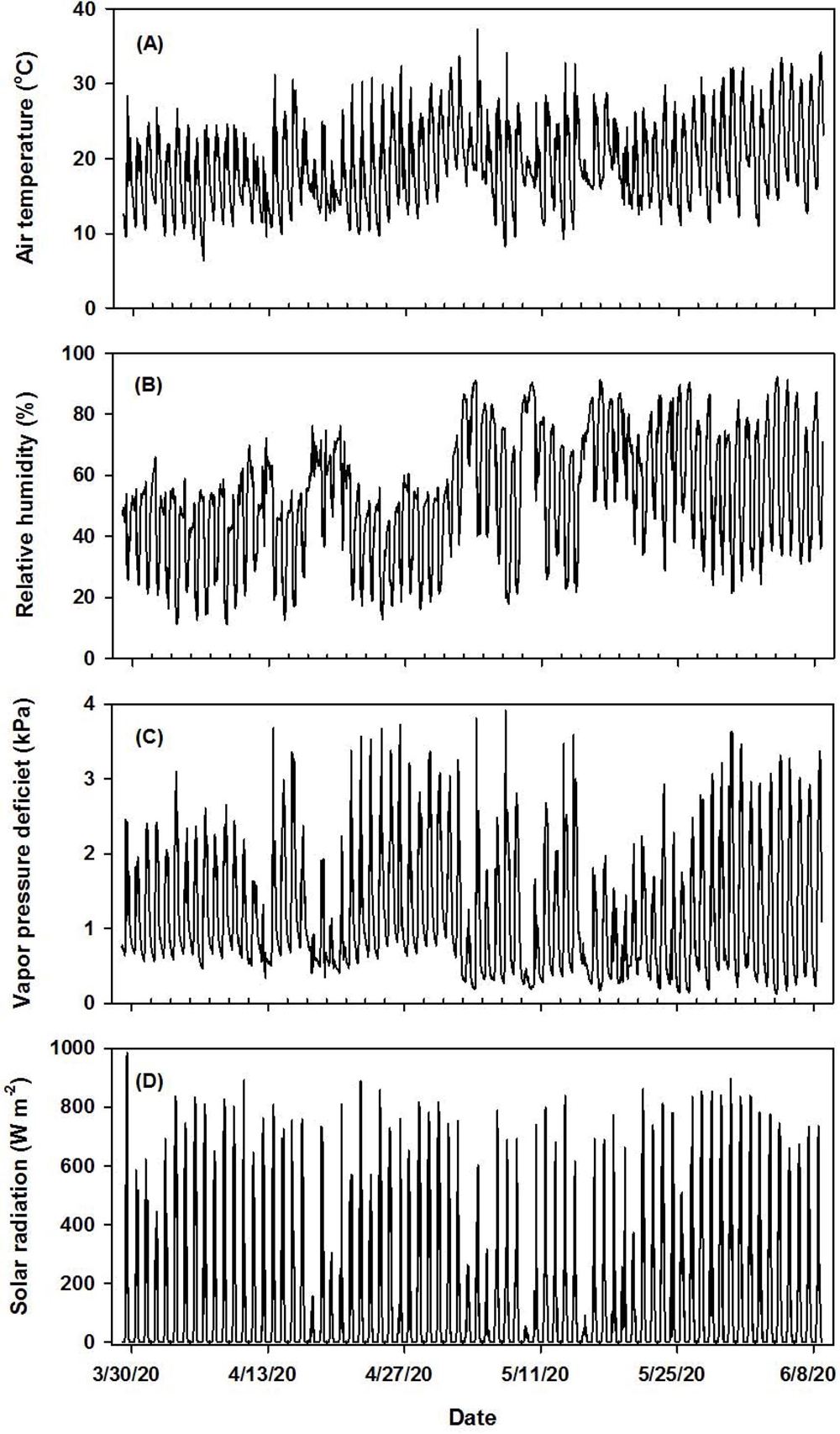
Daily change of air temperature (A), relative humidity (B), vapor pressure deficiet (C) and solar radiation during experiment period.
일사량은 4월 17일, 4월 19일, 5월 3일, 5월 9일, 5월 15일을 제외하고 전형적인 맑은 날씨의 뾰족한 종모양의 일사 형태를 나타내었으며 최대 일사량은 3월 29일에 986 W·m−2로 관측되었다. 대기중 수분 상태와 천궁 잎 표면에서 대기중으로 수증기가 확산 될 수 있는 정도를 평가하기 위하여 수증기압 차이를 분석한 결과 대기중 수증기압 차이는 평균 1.17 ㎪였고 최대 수증기압 차이는 5월 9일에 3.92 ㎪로 대기중으로 수증기가 확산되기 쉬운 조건이었으며, 최저 수증기압은 6월 4일 새벽에 0.13 ㎪로 다소 과습한 조건이었지만 대체로 맑은 날이 많아 천궁의 재배에 적합한 기상조건을 나타내었다.
노지에서는 식물에 유입되는 일사량은 태양의 방위각과 고도각의 변화에 따라 주로 영향을 받지만 온실에서는 시설 구조물에 의한 그림자가 발생하게 되어 위치에 따른 일사 유입량 등의 미기상 환경 차이가 크게 발생할 수 있다. 특히 온실 내 설치된 일사계는 그림자에 의한 일사가 차단 될 수 있으나 라이시미터에 생장하는 천궁은 일부만 그림자가 발생하므로 일사량 관측 자료와 천궁에 유입되는 단파복사량의 차이가 발생하게 된다. 따라서 시설내 구조물 특성에 따른 복사 특성과 환기 등 시설관리에 따른 온도 변화 등의 기상환경 차이를 조사하기 위하여 온실내 미기상 관측자료와 노지 기상 관측자료를 비교하였다 (Fig. 2).
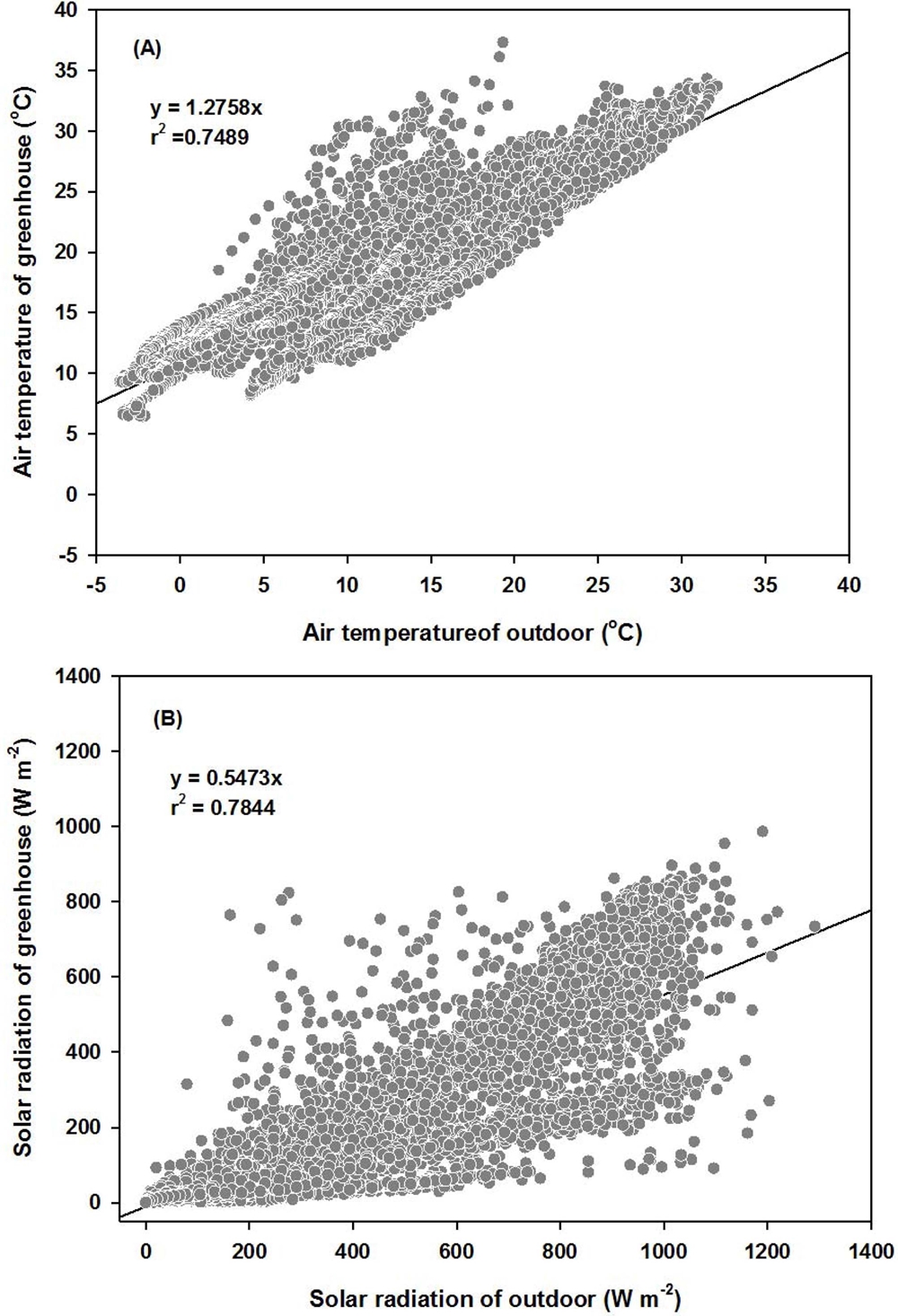
Correlation between the outside and the greenhouse for air temperature (A), solar radiation (B), respectively.
온실 내부와 외부의 기온은 결정계수 0.7489로 선형적인 관계를 나타내었고 기울기는 1.2758로 외부 기온보다 온실이 높은 수준을 나타내었다. 일사량은 결정계수 0.7844로 역시 높은 선형관계를 보였으며 기울기는 0.5473으로 온실내로 유입되는 일사량은 약 46% 정도 감소하는 것으로 나타났다.
2. 엽면적과 증산량 변화
재배기간 동안 천궁의 경시적 엽면적 변화는 Fig. 3와 Fig. 4와 같았다. 천궁 잎출현 10 일 후 엽면적은 1,534.6 ㎝2·m−1, 17 일에는 2,167.1 ㎝2·m−1, 21 일은 2,452.0 ㎝2·m−1, 35 일 5,552.2 ㎝2·m−1, 49 일은 6,195.8 ㎝2·m−1로 증가하였다.
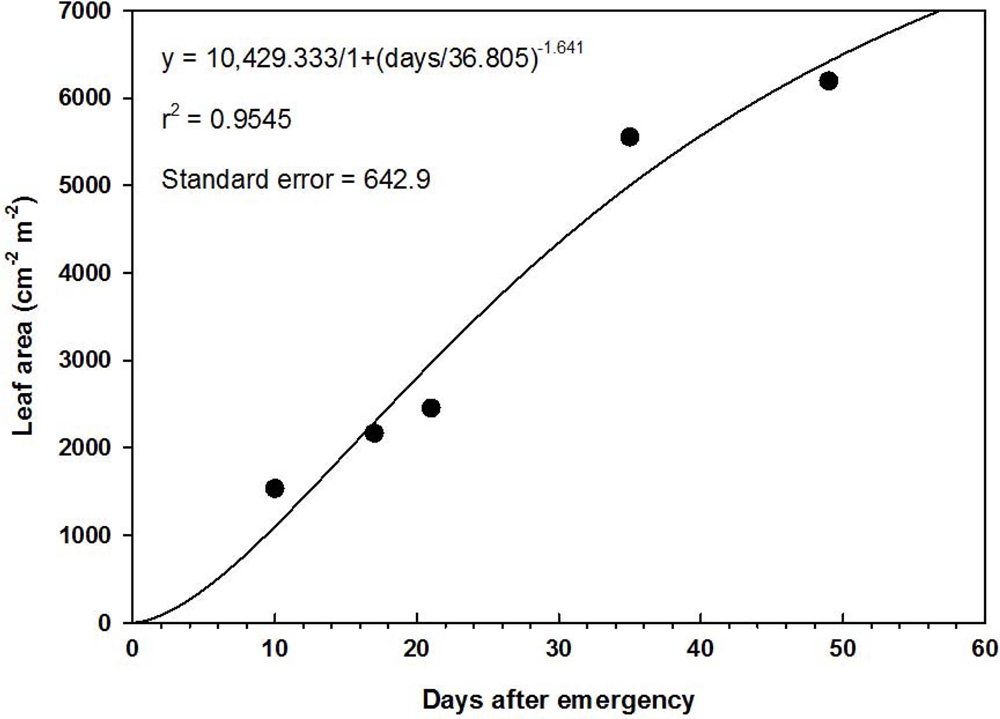
Changes in the leaf area of Cnidium officinale Makino grown in lysimeter during the experiment period.

Growth of Cnidium officinale Makino during the experiment period.(A) 10 days, (B) 21 days, (C) 35 days and (D) 46 days after emerging.
작물이 생장량을 정량적으로 예측하기 위하여 광합성이 이루어지는 엽면적 경시적 변화를 추정하는데 시간에 따라 증가하는 작물의 생장은 세포의 증식 또는 생장을 평가하기 위하여 주로 logistic growth 함수를 사용하며 (Byrne and Drummond, 1981; Ahn et al., 2014), 라이시미터를 이용하여 배추를 온실에서 재배하면서 생장을 평가한 결과 logistic growth 함수와 잘 일치 (r2 = 0.9964)하는 엽면적 증가를 나타내었다고 하였다 (Seo et al., 2019). 본 연구에서도 마찬가지로 시간에 따른 천궁의 엽면적 증가는 생장은 logistic growth 함수와 잘 일치 (r2 = 0.9545)하는 경향을 보였다.
천궁의 단위 엽면적당 증산량은 0.69 ± 0.16 H2O g·㎝−2day−1 (범위 0.45 - 0.86)로 재배기간 동안 큰 차이는 없는 것으로 나타났다 (Fig. 5). 3월 상순부터 4월 하순까지 온실에서 재배된 ‘춘광’ 배추의 단위 엽면적당 증산량은 0.45 ± 0.13 H2O g·㎝−2day−1 (범위 0.28 - 0.67)로 보고하였는데 (Seo et al., 2019), 천궁의 단위 엽면적당 증산량도 배추와 비슷한 수준을 나타내었다.
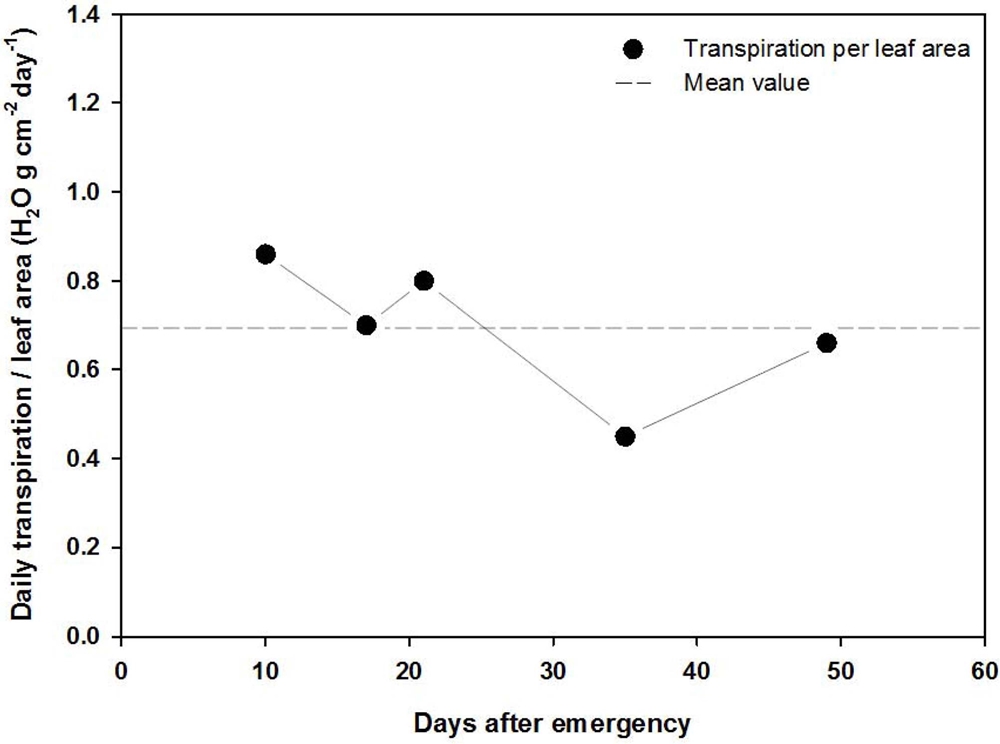
Changes in the daily transpiration per leaf area of Cnidium officinale Makino during the experiment period.
단위 엽면적당 증산량은 차이가 없지만 작물 성장에 따른 엽면적 증가로 태양복사 에너지의 유입 면적은 증가하게 된다. 따라서 일사 유입량에 엽면적을 곱하여 천궁 잎의 수광면적을 보정하여 하루 동안 증산량 변화와의 관계를 조사하였다 (Fig. 6).
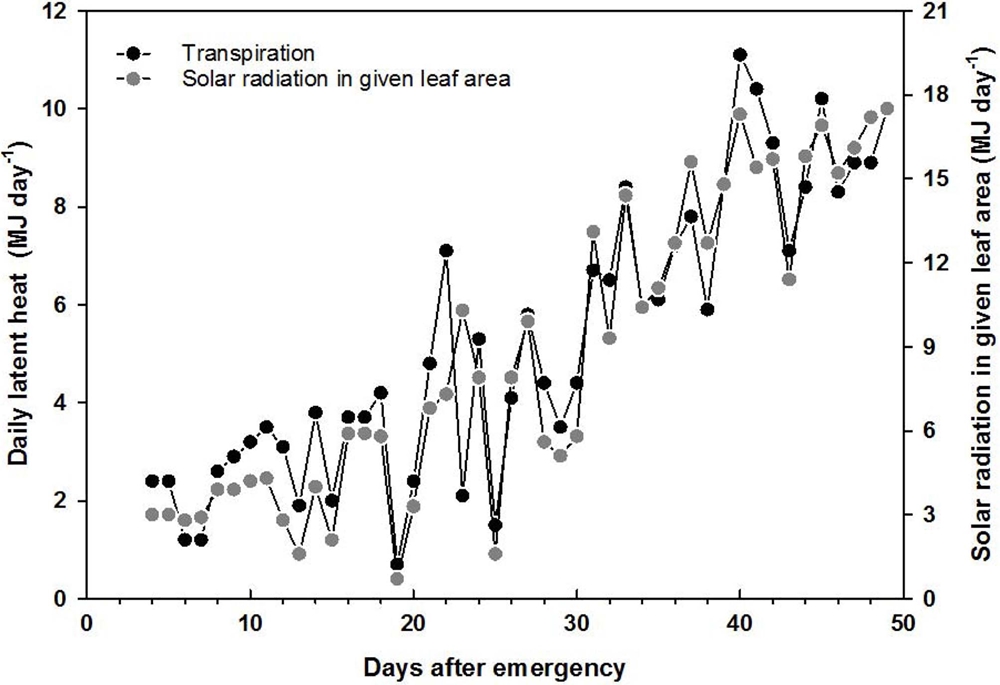
Changes in the transpiration of Cnidium officinale Makino from lysimeter and solar radiation in the given leaf area.Solar radiation in the given leaf area was corrected for logistics regression of leaf area growth calculated by equation of Fig. 4.
천궁 잎 출현 후 20 일까지 유입되는 일사량은 평균 8.1 MJ·day−1, 증산을 통한 잠열 방출량은 평균 2.6MJ·day−1로 일사량 유입에 대한 잠열 방출의 비율은 평균 32.5%로 조사되었다. 21 일부터 29 일까지 유입 일사량의 평균 값은 17.2 MJ·day−1, 잠열 방출량은 평균 4.3MJ·day−1, 일사량에 대한 잠열 방출 비율은 평균 25.4%였고, 30 일에서 39 일까지의 일사 유입량은 평균 27.4 MJ·day−1, 잠열 방출은 평균 6.7 MJ·day−1, 유입 일사량에 대한 잠열 방출 비율은 24.6%였다. 40 일에서 49 일까지의 평균 일사 유입량은 평균 32.0 MJ·day−1, 잠열 방출량은 평균 9.3 MJ·day−1, 유입 일사량의 평균 28.9%가 잠열 에너지로 전환되었다.
재배기간 동안 천궁은 유입된 일사 에너지의 약 30%가 증산을 통하여 대기중으로 잠열을 방출하며, 엽면적당 유입되는 일사량 변화와 동일한 양상으로 변화하였으며 일사량 변화에 밀접한 영향을 받는 것으로 조사되었다.
천궁 잎의 열 수지는 태양 잎으로부터 복사 에너지를 흡수하고 증산에 의한 잠열 냉각과 잎에서 대기로의 적외 방사 및 대류나 전도를 통한 주변으로 열 수송 등에 의해 영향을 받으며 유입되는 복사 에너지가 과다하게 높을 경우 엽온 상승, 생리장해 발생과 생육불량을 초래하며 특히 잠열 냉각은 식물의 일사 >풍속 >온도의 순으로 영향을 받는다고 하였다 (Seo et al., 2018a).
천궁에 유입되는 복사 에너지, 풍속 및 기온의 영향을 고려하여 흑구온도가 45℃ 이상으로 높아질 경우 생육이 정지되고 고사증상이 나타난다고 하였으며 (Seo et al., 2018b), 낮 동안의 기온이 28℃보다 높게 3 일 이상 지속될 경우 고온피해가 발생하기 시작하므로 고온기에 차광재배를 하면 광합성률, 기공전도도, 증산률이 증가하여 효과적이라고 하였다 (Nam et al., 2020).
태양복사인 단파복사는 지표면의 증발산에 가장 큰 영향을 주는 기상요소로서 일사량이 증가와 감소에 따라 잔디의 증발산량도 동일한 형태로 변화하였고 단파복사 유입량과 증발산을 통한 잠열 방출을 계산한 결과 46%가 증발산 에너지로 변환되었다 (Lee and Haginoya, 2011). 해발 고도별 증발산량관측시 단파복사 유입량과 증발산량은 유의한 선형적인 관계를 나타내었다 (Lee et al., 2012).
노지조건에서 라이시미터를 이용하여 천궁의 증발산량 변화를 관측한 결과 증발산량은 일출과 함께 증가하여 정오경에 높아지고 오후에는 다시 감소하는 종 모양의 일 변화를 나타내었고 일사가 없는 야간에는 증발산이 거의 일어나지 않는다고 하였다 (Seo et al., 2018a). 날씨가 맑은 날에 천궁의 시간당 증발산량은 최대 일사량의 차이가 있어도 40 g 내외로 일정한 경향을 나타내었고 일사량에 대한 증발산량의 관계를 회귀분석 결과 600W·m−2까지는 증발산량의 선형적인 증가를 나타내며 그 이상의 일사량에서 증가하지 않았고 관측자료의 계산에서 일사량의 40% 정도가 증발산 에너지로 변화된다고 보고하였다 (Seo et al., 2018a).
기온과 일사량이 천궁의 증산에 미치는 영향을 조사하기 위하여 군락 엽면적이 발달하여 환경변화에도 증산량의 편차가 적고 충분한 증산량을 가지는 5월 25일부터 6월 8일까지 15일간 분석을 하였다. 천궁의 증산은 일출과 동시에 일사량이 증가함에 따라 증산이 높아졌고 일몰과 함께 증산이 낮아지는 경향을 잘 나타내었다. 기온변화에 따른 증산량을 분석하였으며 일출 후에 기온이 높아짐에 따라 증산도 높아지는 경향을 나타내었지만 하루 중 최고기온을 나타낼 때는 증산이 낮아지는 경향을 보였다 (Fig. 7).
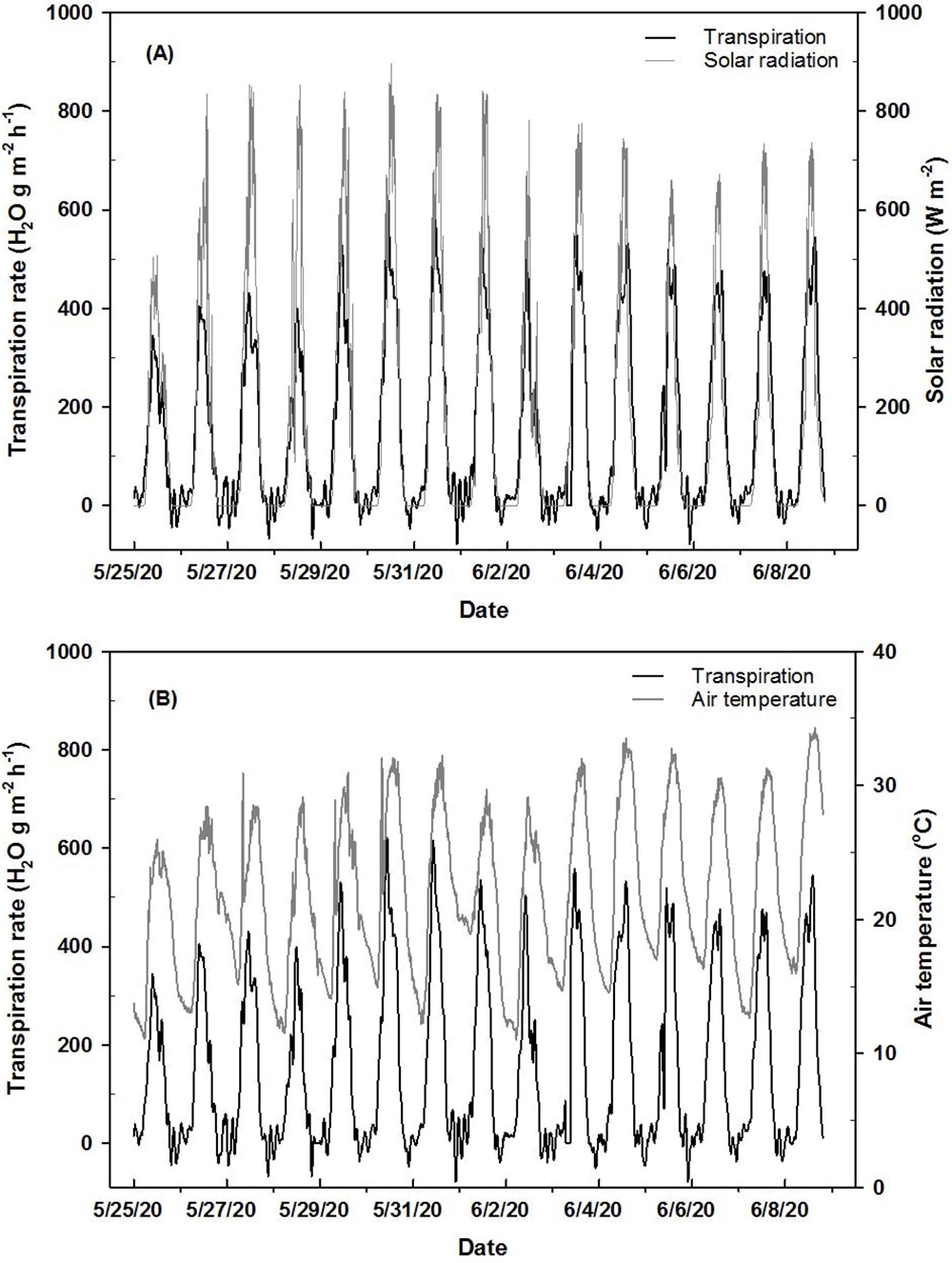
Changes in the transpiration rate of Cnidium officinale Makino according to solar radiation (A) and air temperature (B) from May 25 to June 8 in 2020.
증산률이 가장 높았던 5월 30일 10시 30분에 일사량은 623.5 W·m−2, 기온은 28.8℃였고 5월 31일 10시 30분의 일사량은 459.2 W m−2, 기온은 28.2℃, 6월 3일 11시 30분은 일사량 639.9 W·m−2, 기온은 29.2℃였다. 그러므로 군락을 이룬 상태에서 천궁의 적정 증산에 필요한 일사량은 600 W·m−2 내외, 기온은 30℃ 이하의 조건이 적합한 것으로 판단되었다.
3. 건물 생산량, 탄소 축적량 및 증산과의 관계
재배기간 동안 천궁의 생체중, 건물중, 탄소축적량 및 총 증산량을 조사한 결과는 Table 2와 같았다.

Influence of wind speed on reducing the radiant heat in black globe under different wind conditions.
생체중은 잎이 144.60 ± 23.21 g·plant−1, 근경은 132.30 ± 4.68 g·plant−1, 합계량은 276.90 ± 27.74 g·plant−1이었고 건물중 은잎이 16.07 ± 2.58 g·plant−1, 근경은 14.70 ± 0.52 g·plant−1, 합계량은 30.77 ± 3.08 g·plant−1이었다. 건물 생성량에 탄소계수 0.4를 곱하여 구한 천궁의 총 탄소량은 12.31 ± 1.23 g·plant−1으로 포도당의 생성량은 0.17 ㏖로 산출되었다. 재배기간 동안 천궁의 총 증산량은 10,006 g·plant−1으로 555.89 H2O ㏖이었고 천궁 생체에 포함된 수분의 양을 계산하면 276.93 g·plant−1로 15.39 H2O ㏖로 총 증산량에 대한 건물 생산량의 비율은 0.31%, 탄소 축적량의 비율은 0.12%로 산출되었다. 온실에서 재배한 배추의 경우 총 증산량에 대한 건물 생산량은 평균 0.33%와 탄소 축적량은 0.13%를 나타내었으며 (Seo et al., 2019) 천궁을 대상으로 한 본 연구결과와 유사한 결과를 나타내어 증산과 건물 생산량 및 탄소 축적은 밀접한 관계가 있는 것으로 조사되었다.
따라서 일반적인 광합성 식은 6CO2 + 6H2O → C6H12O6 + 6O2로 표현하는데, 본 연구에서 재배기간 동안 천궁의 광합성 반응식은 Eq. (1)과 같이 표현 될 수 있다. 따라서 천궁의 재배 과정 중 흡수된 수분의 97%는 증산에 의해 잠열로 방출되어 식물체내 열에너지의 소산에 대부분 이용하는 것으로 분석되었다.
| (1) |
WC; Water content of fresh Cnidium officinale (H2O ㏖)
TR; Water content of by transpiration (H2O ㏖)
그러므로 라이시미터를 이용하여 높은 정확도로 천궁의 실시간 증산량 관측이 가능한 것으로 확인이 되었고, 증산량 관측을 통하여 생장해석에 매우 유용하게 활용이 가능할 것으로 사료된다.
Acknowledgments
본 연구는 농촌진흥청 연구사업(과제번호: PJ014820052020)의 지원에 의해 이루어진 결과로 이에 감사드립니다.
REFFERENCES
-
Ahn JH, Kim KD and Lee JT. (2014). Growth modeling of Chinese cabbage in an alpine area. Korean Journal of Agricultural and Forest Meteorology. 14:309-315.
[https://doi.org/10.5532/KJAFM.2014.16.4.309]

- Baek IS, Park CS and Park CG. (2003). The effects of Cnidium officinale extract on the ischemic stroke and oxidative neural damage in rats’ brain. Korean Journal of Herbology. 18:37-46.
- Bakhtiari B, Gahreman N, Lighat AM and Hoogenboom G. (2011). Evaluation of reference evapotranspiration models for a semiarid environment using lysimeter measurements. Journal of Agricultural Science Technology. 13:223-237.
-
Byrne GF and Drummond JE. (1981). Fitting a growth curve equation to field data. Agricultural Meteorology. 22:1-9.
[https://doi.org/10.1016/0002-1571(80)90023-0]

- Choi SY, Chang KJ, Lee KC and Park CH. (2000). Effect of mulching and shading on growth and yield of Ligusticum chuangxion Hort. and Cnidium officinale Makino. Korean Journal of Medicinal Crop Science. 8:209-215.
-
Colaizzi PD, O’Shaughnessy SA, Evett SR and Mounce RB. (2017). Crop evapotranspiration calculation using infrared thermometers abroad pivots. Agricultural Water Management. 187:173-189.
[https://doi.org/10.1016/j.agwat.2017.03.016]

-
Djaman K, O’Neill M, Owen CK, Smeal D, Koudahe K, West M, Allen S, Lombard K and Irmark S. (2018). Crop evapotranspiration, irrigation water requirement and water productivity of maize from meteorological data under semiarid climate. Water. 10:405-422.
[https://doi.org/10.3390/w10040405]

- Hur SO, Jung KH, Ha SK and Kim JG. (2006). Evaluation of meteorological elements used for reference evapotranspiration calculation of FAO Penman-Monteith model. Korean Journal of Soil Science and Fertilizer. 39:274-279.
- Kim JC, Jang WC, Son HR, Seo YJ, Lee JP and Park HR. (2013). Medicinal plants in living. Daechangsa. Daegu, Korea. p.361.
-
Kim JM, Son D, Lee P, Lee KJ, Kim H and Kim SY. (2003). Ethyl acetate soluble fraction of Cnidium officinale Makino inhibits neuronal cell death by reduction of excessive nitric oxide production in lipopolysaccharide-treated rat hippocampal slice culture and microglia cells. Journal of Pharmacological Science. 92:74-78.
[https://doi.org/10.1254/jphs.92.74]

- Korea Pharmaceutical Traders Association(KPTA). (2018). http://www.kpta.or.kr/, (cited by 2020 June 10).
-
Lee BY and Haginoya S. (2011). The latent heat exchange on the ground. Journal of Environmental Sciences. 20:1061-1068.
[https://doi.org/10.5322/JES.2011.20.8.1061]

-
Lee BY, Yang SK, Kwon KH and Kim JB. (2012). The effect of evapotranspiration by altitude and observation of lysimeter. Journal of Environmental Sciences. 21:749-755.
[https://doi.org/10.5322/JES.2012.21.6.749]

- Lee JH, Choi HS, Chung MS and Lee MS. (2002). Volatile flavour components and free radical scavenging activity of Cnidium officinale. Korean Journal of Food Science and Technology. 34:330-338.
- Ministry of Agriculture, Food and Rural Affairs(MAFRA). (2018). Production statistics of special crops. Ministry of Agriculture, Food and Rural Affairs. Sejong, Korea. p.51.
-
Nam HH, Jang WC and Seo YJ. (2020). Effect of shading types and duration on alleviation of high temperature stress in Cnidium officinale Makino. Korean Journal of Medicinal Crop Science. 28:111-118.
[https://doi.org/10.7783/KJMCS.2020.28.2.111]

- National Institute of Agricultural Science(NIAS). (2000). Soil and plant analysis. National Institute of Agricultural Science. Rural Development Administration. Suwon, Korea. p.103-126.
- Oh YJ, Seo HR, Choi YM and Jung DS. (2010). Evaluation of antioxidant activity of the extracts from the aerial parts of Cnidium officinale Makino. Korean Journal of Medicinal Crop Science. 18:373-378.
- Ok JH, Han KH, Lee YJ, Zhang YS, Cho HR, Hwang SA, Kim SS, Lee JH and Kim DJ. (2018). Water balance for Chinese cabbage in spring season with different upland soils evaluated using weighable lysimeters. Korean Journal of Soil Science and Fertilizer. 51:555-563.
-
Rana G and Katerji N. (2000). Measurements and estimation of actual evapotranspiration in the field under mediterranean climate: A review. European Journal of Agronomy. 13:125-153.
[https://doi.org/10.1016/S1161-0301(00)00070-8]

-
Renner M, Brenner C, Mallick K, Wizemann HD, Conte L, Trebs I, Wei J, Wulfmeyer V, Schulz K and Kleidon A. (2019). Using phase lags to evaluate model bias in simulating the diurnal cycle of evapotranspiration: A case study in Luxembourg. Hydrology Earth System Science. 23:515-535.
[https://doi.org/10.5194/hess-23-515-2019]

-
Seo MJ, Han KH, Jung KH, Cho HR, Zhang YS and Choi SY. (2016). Effect of temperature and plow pan on water movement in monolithic weighable lysimeter with paddy sandy loam soil during winter season. Korean Journal of Soil Science and Fertilizer. 49:300-309.
[https://doi.org/10.7745/KJSSF.2016.49.4.300]

- Seo YJ, Nam HH, Jang WC, Kim JS and Lee BY. (2018a). Effect of meteorological factors on evapotranspiration change of Cnidium officinale Makino. Korean Journal of Agricultural and Forest Meteorology. 20:366-375.
- Seo YJ, Nam HH, Jang WC, Kim JS and Lee BY. (2018b). Developing a model for estimating leaf temperature of Cnidium officinale Makino based on black globe temperature. Korean Journal of Medicinal Crop Science. 26:1-8.
- Seo YJ, Nam HH, Jang WC, Kim JS and Lee BY. (2019). Lysimeteric evaluation for transpiration and carbon accumulation of Kimchi Cabbage(Brassica rapa L. ssp. pekinensis). Korean Journal of Soil Science and Fertilizer. 52:235-248.
-
Um JN, Min JW, Joo KS and Kang HC. (2017). Antioxidant, anti-wrinkle activity and whitening effect of fermented mixture extracts of Angelica gigas, Paeonia lactiflora, Rhemannia chinensis and Cnidium officinale. Korean Journal of Medicinal Crop Science. 25:152-159.
[https://doi.org/10.7783/KJMCS.2017.25.3.152]

- Yi EJ. (2004). Control of citrus blue mold and chili pepper anthracnose by ligustilide and antifungal compound from Cnidium officinale Makino. Master Thesis. Seoul National University. Seoul, Korea. p.37-50.